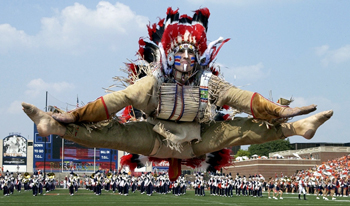Here's the text of the story and a key excerpt:
The Ransom of Red Chief
Bill was pasting court-plaster over the scratches and bruises on his features. There was a burning behind the big rock at the entrance of the cave, and the boy was watching a pot of boiling coffee, with two buzzard tailfeathers stuck in his red hair. He points a stick at me when I come up, and says:
"Ha! cursed paleface, do you dare to enter the camp of Red Chief, the terror of the plains?
"He's all right now," says Bill, rolling up his trousers and examining some bruises on his shins. "We're playing Indian. We're making Buffalo Bill's show look like magic-lantern views of Palestine in the town hall. I'm Old Hank, the Trapper, Red Chief's captive, and I'm to be scalped at daybreak. By Geronimo! that kid can kick hard."
Yes, sir, that boy seemed to be having the time of his life. The fun of camping out in a cave had made him forget that he was a captive, himself. He immediately christened me Snake-eye, the Spy, and announced that, when his braves returned from the warpath, I was to be broiled at the stake at the rising of the sun.
Mostly, though, its used in high schools to teach about irony, and, that crime doesn't pay. Looking over the lesson plans, I find things like "Red Chief is a holy terror at the beginning of the story, and he is still a terror at the end."
Comment: It's one thing to preserve this story in the literary record. But Reese implies that people use it today and no one notices or teaches about its blatant stereotypes.
This is a little hard to believe. It's not as if it's a great story. The idea is cute, but the actual text is tiresome. I'm guessing most people today would skim it to get the gist of it.
But given the public's fawning appreciation of the stereotypes in The Adventures of Huck Finn and Little House on the Prairie, it shouldn't surprise us that people like this story. In literature as in history, our culture is all about mythologizing the past. I.e., celebrating the good things and ignoring the bad things.
From Columbus to the Pilgrims to Independence Day to settling the West, our story is that we're the people chosen to implement God's will. The fact that God's will involved killing and enslaving people rarely gets mentioned.
Apparently, it doesn't matter how racist The Ransom of Red Chief is. American schools and businesses see it as useful moral instruction: "Be careful what you wish for." Similarly, it doesn't matter how racist US history is. Despite centuries of genocide and slavery, Americans see it as something to celebrate unreservedly.
Below: "I'm a wild Indian! Just call me Red Chief!"


1 comment:
wow, what a picture that is! the last one, amazing.
Post a Comment